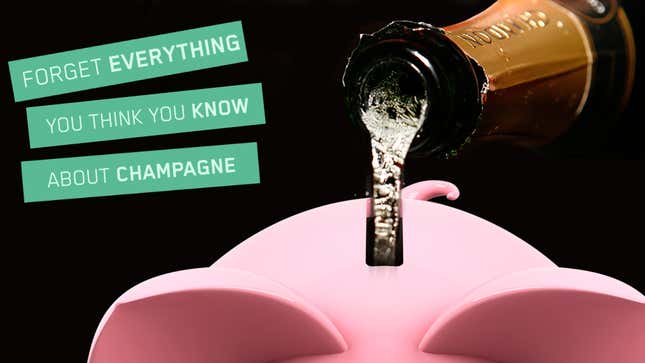
Let me begin with an uninformed and yet almost certainly accurate assumption: you drink champagne at most twice a year, one of which is the perfunctory glass on New Year's Eve that you end up blaming for your hangover the next morning instead of the 14 Red Bull vodkas you blasted between 1 and 3 a.m. You think champagne is for some rich snobs out celebrating how their latest round of layoffs will drive their stock price up an additional 0.4% in the next quarter. You think of it as something that rappers use to spray on strippers and unlucky nightclub patrons. You think it is overpriced, gives you nasty headaches, and delivers a weak buzz. Well, you could not be more wrong.
Champagne is excellent. No one walks into a restaurant and orders a flat Coke, so why do we reflexively do this with our wines? Champagne is light, delicious, and effervescent. It is impossible to drink it without a smile on your face. The clinking glasses, the endless streams of tiny bubbles, being able to say "ahhh…" after every sip, as if you just got your first taste of Gatorade after a marathon: this is a drinking experience you just cannot match with a merlot. And, done right, there's no reason why drinking champagne has to be more expensive or more likely to result in a hangover than any other wine.
Now, this guide is not for everyone. If you want to drink champagne to impress your audience, skip all this and just go order a bottle of Armand de Brignac (which you will, obnoxiously, refer to as "Ace of Spades")—being sure to casually mention the price to everyone within earshot while you pretend that you chose it because you "only drink the best," and not because it is carbonated slightly-fermented grape fruit juice in a cool bottle that's being marked up 12,000% by Jay-Z. Conversely, you might be the sort of PBR-drinking hipster who always buys the cheapest bottle regardless of quality. Great. Korbel and Freixenet sell 8 jillion bottles a year to people who proudly announce that they cannot tell the difference between the cheap stuff and the good stuff. If you want to revel in your ignorance, I can't help you either, and you may as well go fill up your Solo cup with whatever is on special at the Stop n' Shop rather than reading any further.
Still reading? Congratulations! Everyone who stopped reading after the last paragraph is an asshole! We're all better off without them, especially since their page views already were counted. Now, we're ready to begin your education.
First, forget everything you think you know about champagne. It may surprise you to learn that the two names you already know, Moet & Chandon and Veuve Cliquot, are not the finest champagnes in the world—not by a longshot—they are the most widely produced. And like all popular mass produced products they're both designed to appeal to a mushy middle of uninformed people who can only respond to what they've seen in advertising. We'll talk about what you should buy instead of them in just a minute. (If, ultimately, you're still determined to order them because you're pretty sure they're the only names you'll remember, at least learn to pronounce them properly. Biggie was wrong and Ice-T was correct: it is "Mo-Et," not "Mo-Way" and Veuve is not "Vooov," it is "Vuhv.")
Second, let's master a few very basic concepts about champagne that can allow you to talk like an informed connoisseur without sounding like a pretentious prick.
- Champagne can only come from the Champagne region in Northern France. Anything else is a sparkling wine regardless of what's written on the label of some low-end California sparklers. There's nothing wrong with a non-Champagne sparkling wine—indeed, I'll mention several worthy of your consideration—but since we live in a society that so values precision that waiters will invariably ask you if Sprite is OK when you order 7-Up, as if anyone in history has every answered "no," you, Mr. or Mrs. Newly Minted Champagne Connoisseur, should be able to correctly distinguish champagne from sparkling wine.
- Almost all champagnes are made from some combination of Chardonnay, Pinot Noir, and Pinot Meunier grapes. A blanc de blancs is made from exclusively the light Chardonnay grapes, and a blanc de noirs is made from the dark Pinot Noir and Pinot Meunier grapes. Most champagne is a blend—or cuvee—of all three.
- A non-vintage champagne consists of a blend of grapes from various vineyards and years of harvest designed to produce a uniform taste year after year. In general, non-vintages are less expensive and less highly regarded than their vintage counterparts for the same reasons that single-malt scotches tend to command a premium over their blended cousins: Not only do blended wines lack the unique character that individual vintages may possess, the act of blending allows a vintner to incorporate cheaper ingredients and cover up any deficiencies in its mass-produced blend. Of course, most of that is meaningless to your tongue. Non-vintages can be a great value and deliver consistent flavor. Plus, if you stick to non-vintages, you'll never have to recite things like, "Oh, 1986 was a very good year for pinot noir in that part of France," which, even if true, make you look like an incredible asshole who has a better memory for obscure grape harvests than, say, the names of the children of your dining companions, including those of your own spouse. Non-vintages—typically indicated NV—are a great way to go for the price-conscious and new champagne drinkers.
- A prestige cuvee is the finest champagne made by a vintner. Prestige cuvees are made from only the finest grapes and almost invariably are associated with a specific vintage (that is, the grapes were all picked in the same season, as distinguished from a non-vintage). The most famous example of a prestige cuvee is Dom Perignon, which is the top of the line champagne for Moet & Chandon.
- There is only one badass way to open a champagne bottle: sabering it.
- The grandes marques are the twenty-four champagne houses that dominate the present market. Examples would include the aforementioned Moet & Chandon and Veuve Cliquot, as well as high-end niche players like Salon and Krug. The marque refers to the house's entire line, so in the case of Moet & Chandon, it would cover everything from the non-vintage Brut Imperial or White Star up to the Dom Perignon prestige cuvee. See? Wasn't that easy? You already understand the champagne business!
Third, you'll be happy to know that champagne is surprisingly easy to care for. Champagne snobs will tell you that you should cellar champagne at temperatures around 54 degrees Fahrenheit, but that's because they're snobs. Saying idiotic stuff like that is the only way they can justify spending hundreds of thousands of dollars building an addition to their home to house a cooling system that was effectively rendered obsolete by the invention of ice. Your fridge will work fine 99% of the time, especially if you—like me—typically plan to drink a bottle within a few days of buying (or, don't plan to do so, but will inevitably do so anyway because it's the only drink in the house and you're a degenerate). If you do want to invest in a nice storage system, you can pick up an electronic champagne cave for around $100 that will allow you to store your new collection at a perfect temperature until you are ready to enjoy it—but of course, you're ready to enjoy it now, so why bother?
And what about the situation where you just want to have a quick glass or two while you and the wife watch Giada whip up a delicious looking dish from simple household ingredients, as you two discuss whether, with just a bit more hard work around the kitchen, you, too, could be a talentless heiress to a massive Hollywood fortune who undeservedly gets her own TV cooking show? Well, assuming you haven't smashed the bottle to bits in frustration, there's an easy way to keep its contents fresh and fizzy. It's called a champagne stopper, it works perfectly and it will run you about $3. Avoid designs other than the basic dual-clamp, especially the fancy Le Creuset types; they not only cost more, they don't work as consistently.
Now that you've absorbed this universe of knowledge, let's get you started destroying your short-term memory. Below I list the five best champagnes for new champagne drinkers. All are non-vintages and can be readily had for $50 or less online or at your local liquor store.
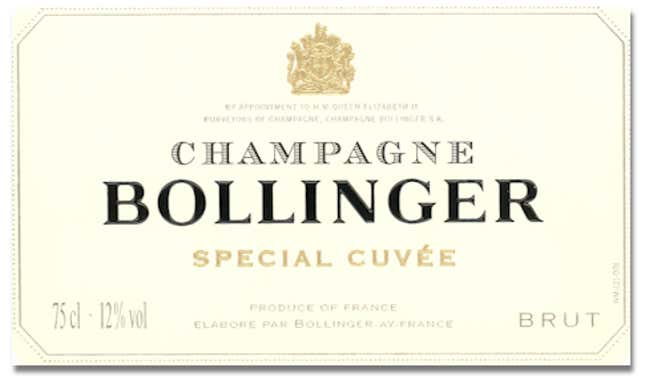
5. Bollinger Special Cuvee ($40-50): This is the non-vintage offering from one of the finest champagne houses in the business. Robert Parker gave it 91 points and called it "fabulous," while described it as possessing "[h]ints of pears, pastry crust and hazelnut [that] lead to an expansive core of fruit." That's a bit much for me. I'd say it's yeasty and full-bodied and it makes my mouth happy when in it's in it, which is really all I can ask for in a champagne.
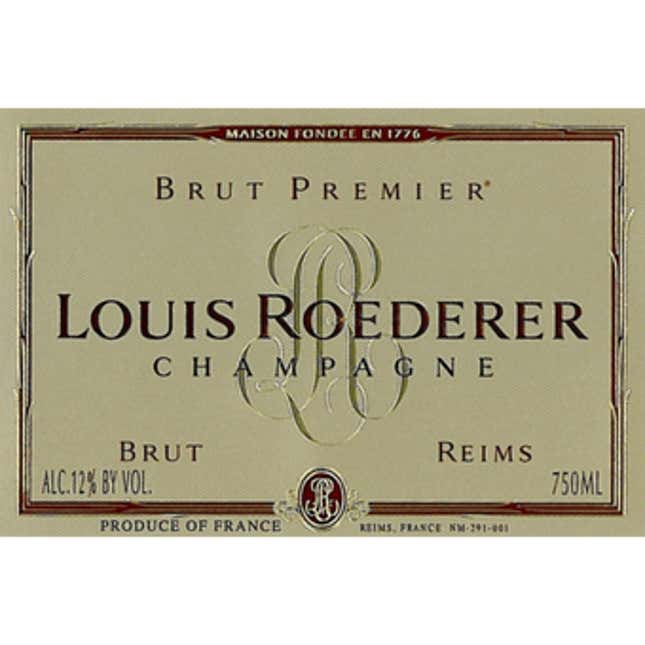
4. Louis Roederer Brut Premier ($40): Even if you know nothing about champagne, you've undoubtedly heard mention of Roederer's prestige cuvee, Cristal. Well, the non-vintage may lack the bling factor that Cristal possesses, but it doesn't lack much else. This is delicious, elegant champagne that would be at home at any dinner party, from the finest black tie affairs to the motley crew of losers you might have over on a Saturday night. It even comes wrapped in a beautiful light cellophane that makes for a gorgeous presentation. A full sensory delight.
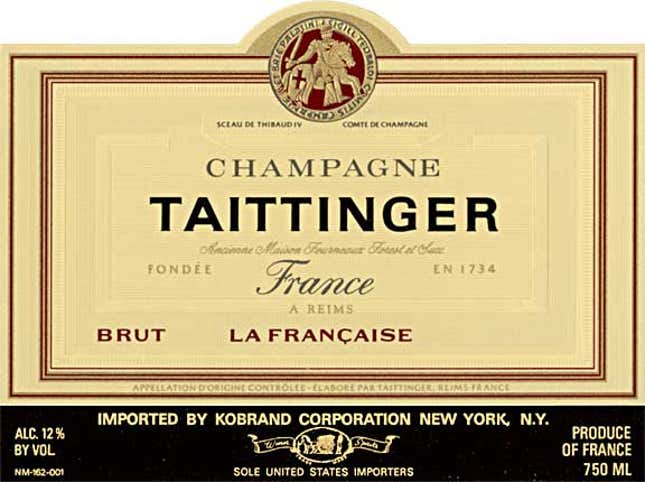
3. Taittinger Brut La Francaise ($35-45): This is one of my all time favorite wines from the third-oldest and arguably the best-rounded marque in the business. It's light, almost peachy in its fruit, with lots of fizz. But be warned: it can also serve as a gateway drug for Taittinger's sumptuous prestige cuvee, Comtes de Champagne, which is so good that you would gladly torture an adorable stray puppy just to get an extra sip of it.
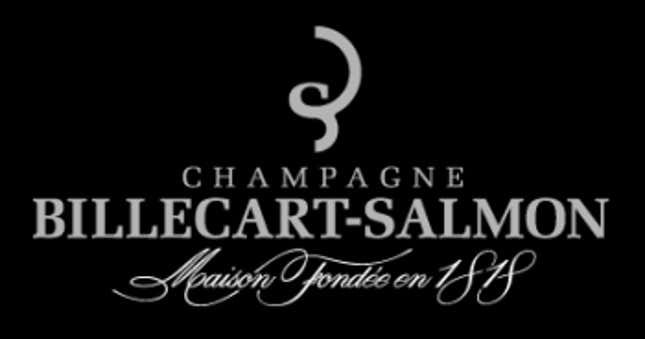
2. Billecart-Salmon Brut Reserve ($40): The only complaint I can muster about Billecart-Salmon is that it can be slightly harder to find than some of its brethren, but your effort will surely be worthwhile once you succeed. Billecart is fresh and smooth, with a delightful bouquet of pears and apples. A true gem from a smaller house whose unique, hands-on approach make every taste a delight.

1. Pol Roger Brut Reserve ("White Label") ($40): Ah, Pol Roger. The choice of Winston Churchill, who would eventually serve as the namesake for its prestige cuvee. Pol Roger is what I can only assume Jesus converted water into, at least if you believe he truly is the savior of mankind. It is light, airy, with hints of tart apple. Pair it with some gruyere cheese and you're in heaven, although you could probably pair it with Cheez-Whiz and have a pretty good evening here on Earth. You simply must try the stuff if you have the opportunity. Remember: it's so good that it literally helped to defeat Hitler!
Now, let's assume that a $40 bottle still seems like a bit much, especially if you're new to the champagne arena. Well, there's good news: there are still plenty of great sparkling wine options that can be had for under $20. A fine bottle of champagne, like those above, is something special for a holistic experience to be savored long into the future. There's no need to spend that much if you're just looking to have a fun time and get blotto. Here's a short list of terrific options for those looking for an option that you'll probably enjoy more than middling champagnes, like Moet & Chandon White Star and Perrier-Jouet, at a third the price.

Domaine Carneros ($20): From the Taittinger house, the Domaine Carneros label produces, at least in my opinion, the finest mass produced sparkling wine from outside the Champagne region, and one that is every bit on par with most of those from within it. Tasting notes compliment its "nicely balanced acidity," describe it as possessing a "crisp mousse of tiny bubbles," and praise its "classy potential for cream-biscuity complexity." Whatever. It's just delightful. It is among the top 10 sparklers one can purchase for under $100 and easily tops the list of those that can be had for under $20.

Roederer Estate Brut Non-Vintage ($20): This is another outstanding sparkler that can trace its roots back to a grande marque in France. In this case, it comes from Louis Roederer's vineyards in the Anderson Valley of Northern California. While not quite on par with the Champagne original, this wine shows much of the freshness and sophistication of its big brother. It's delicious and worthy of sharing in the Roederer name.

Gruet Brut Non-Vintage ($12): A recommendation that comes from … New Mexico? Called … well, hell, I haven't the slightest idea how to pronounce it. Grew-eht? Groot? Grooo-way? Who cares? It is a really nice and surprisingly sophisticated sparkler than can be had for not much more than a comparable quantity of Korbel. Gruet tastes like an authentic French wine and yet beats almost all of its inferior domestic competitors for price. You simply cannot go wrong with it.
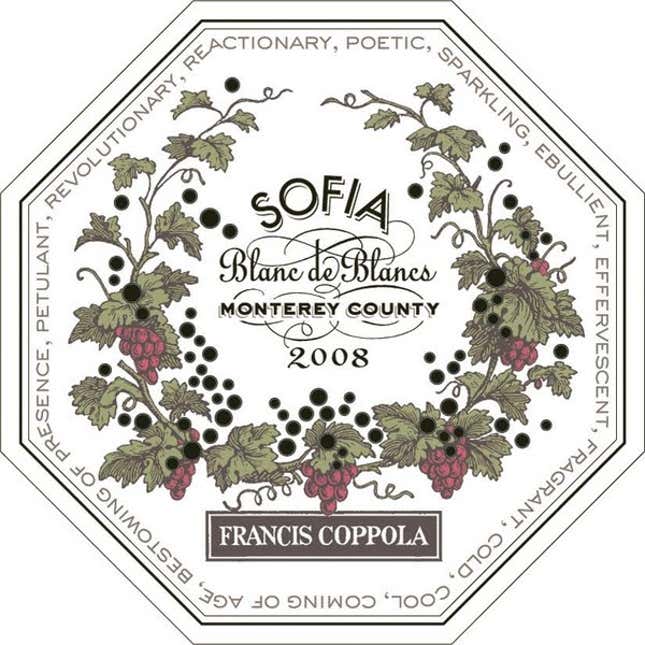
Sofia ($12): Finally, this fun little blanc de blancs (made not from Chardonnay but Pinot Blanc, Muscat and Riesling) from the Coppola Winery is, at minimum, more enjoyable than any of the films starring or directed by its namesake. As a sparkling wine, its quality cannot match Gruet or the other stalwarts in its price class. But you can get it in individual serving cans! CANS! If you do opt for the bottle, you get a lovely presentation in a pink cellophane wrapper, but very uneven taste from bottle to bottle. On its best days, it's effervescent and sweet—likely owing to the Muscat and Riesling in its formulation—but I've had bottles that seemed to lack all carbonation and flavor. But why are we even talking about bottles when you can get it in cans? You realize what this means, right? You can shotgun sparkling wine. How you like them apples, Robert Parker?
Congratulations. You've learned a lot today. You've learned champagne terminology, you've learned a bit about the business, and you've learned about a number of terrific options that will be in the budget of almost any wine drinker. More importantly, though, you've learned that champagne can be a fun drink for any occasion. There's no reason you can't pop the cork to celebrate a good day at the office, a lunch with a friend you haven't seen in months, or just a nice quiet dinner with someone special. Hell, you can do it just to celebrate reading this article. And, most importantly, you've learned that there's not even a need to pop a cork when you're not in the mood because you can get Sofia in CANS!!!
Iron Mike Gallego is a Deadspin commenter, inveterate champagne drinker, and degenerate boxing fan. Direct all complaints to [email protected] or @ironmikegallego on Twitter.
Image by Sam Woolley.